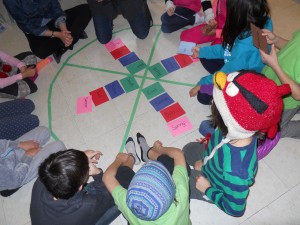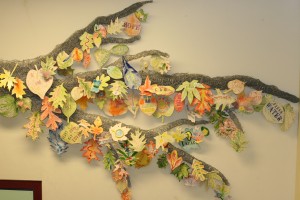While Iãve been busy with collaborative eco-art installations with my students this winter, summer always gives me a little more time to work on my personal artworks.ô Iãve been experimenting with sculptural book-making in recent years ã I love the combination of text and image, and the surprise of taking a traditionally flat object and making it come alive in three dimensions.ô So how do you make this technique more eco-friendly?ô Working with paper is a first step as it is easily biodegradable – that’s a natural when it comes to book-making.ô But Iãve also been drawing inspiration from a variety of sources, looking for ways to incorporate natural or found objects into my bookworks.ô I love the Spirit Books of Susan Kapuscinski Gaylord (http://www.susangaylord.com/the-spirit-books.html), who uses branches, grapevine and dried berries in this evocative book series.ô Mary Ellen Campbellãs books also incorporate a range of natural materials, often layering one on top of the other for a beautiful effect (find examples of her work on Pinterest.)ô Basi Irland takes a very different approach, freezing water and seeds into book forms that become part of a community performance as they float downstream (http://www.basiairland.com).ô If youãre looking for exemplars of how to re-use found objects and turn them into books, look no further than Terry Taylorãs EcoBooks: Inventive Projects from the Recycling Bin.ô Once youãve read this book, youãll be excited to try this yourself ã youãll be seeing possible books in everything you discard!
For the Birds: Raising Awareness about FLAP
We finished our FLAP 2.0 eco-art installation just in time for World Migratory Bird Day on May 10th!ô The work focuses on the plight of migratory birds in urban environments by depicting dozens of Ontario birds taking flight, using artistic means to raise awareness about FLAP ã the Fatal Light Awareness Program.ô Representing the millions of birds killed annually in collisions with buildings, this artwork is an aesthetic form of eco-justice education, encouraging viewers to consider the needs of all living things in the creation of more sustainable ways of living.ô Each bird was drawn or painted by a member of the OISE community, then scanned and printed onto an adhesive material made from 100% recycled plastic. This art installation is part of the ‘Take the Stairs’ Campaign, forming part of the walking art gallery that encourages the OISE community to take the stairs, rather than elevators (conserving energy and improving health and wellness of the walkers). To see some of the detailed images from this installation, visit my February post. ô To find out more about FLAP, go to: ô http://www.flap.org/ ô and ô WM Bird Day at:ô http://www.worldmigratorybirdday.org/ô ô What creative act could you do ãfor the birdsã?
Nature is the best art supply store!
The snow is just melting here, and we Canucks are emerging from the comfort of our well-insulated abodes to rediscover the beauty of a warmer natural world.ô I get excited about the idea of my gardens starting to grow again; spring, after a long winter, is always a hopeful time of year.ô One of the things I start to dream about is using more natural materials in my artworks:ô what new material can I find?ô What new material will find me?ô Nature is the best art supply store; the materials are plentiful, inexpensive, biodegradable, and if harvested properly, sustainable as well. ô I often get asked about the ethics of harvesting natural materials, especially in urban spaces; I think that, in many ways, going all natural is more ethical than using manufactured materials.ô The latter typically has a much bigger ecological footprint, and is more toxic, so moving to biodegradable materials can certainly be a positive step in the right direction.ô But ensuring that you are finding sustainable sources of natural materials, that don’t harm their living sources, is crucial.ô So a few ideas for including more natural materials in your art-making:
- painting on leaves, rocks, or bark
- dyeing fabric with natural dyes made from onions, beets, red cabbage, etc.
- creating collages made with natural materials
- pressing natural materials into wet clay to make tiles or ãfossilsã
- rubbings of natural textures (leaves work beautifully for this)
- blowing bubbles with food dye and pressing onto paper
- making handmade paper with natural components such as seeds or leaves
- using branches as ãframeã for weavings
- using beeswax as pigment or adhesive
For more ideas, check out the following website:
Art and your Natural Environmentô ô http://arts.umich.edu/programs/funpages/environmentart/
Flapping Again!
We’re flapping again!ô A few years ago at OISE we did an eco-art project to raise awareness about the plight of migratory birds in urban environments as part of FLAPô – the Fatal Light Awareness Project.ô At that time I worked with my students to create over 300 handmade relief prints that were distributed to OISE offices to encourage faculty and staff to turn off their lights and close their blinds at night to reduce bird collisions with their windows.ô We had such a positive response to these prints that we’re working on FLAP 2.0 – an art installation to raise awareness for the rest of the institution.ô Working with our students, we’re in the process of making over a hundred watercolours of birds indigenous to south-western Ontario.ô These bird artworks are being scanned and printed onto a type of plastic/paper with an adhesive backing (made from 100% recycled plastic!), and then will be cut out to make life-sized bird stickers.ô They will be grouped into a huge flock in our walking art gallery (in the main stairwell), hopefully causing a FLAP when they are unveiled!ô Here are a few images that have been created so far…photos of full installation will be posted on my website early next summer.
Planting the Seeds for Environmental Stewardship
I worked on an environmental art project with a local Catholic school this fall, thanks to a great collaboration between Arts for Children and Youth (AFCY) and the Friends of Roseneath Park.ô Roseneath is a small park located in central Toronto, sadly neglected and full of litter from a nearby parking lot, until the Friends group contacted AFCY to help deepen the communityãs sense of connection to it.ô They started with a community mural project this last summer – a photo of part of it is below. ô I was invited to work with local school children in grades 3 and 4 to heighten their awareness of the park, and hopefully strengthen their sense of stewardship for it.ô We used a ãtreasures and troublesã approach, searching for the environmental strengths and challenges of their schoolyard at first, and then the park, working towards growing an understanding that both humans and more-than-humans share a desire for an environment that is free of garbage, with clean air, water, and lots of trees and plants.ô The children relished an opportunity to learn outside, even in the chilly weather of late October, and took wonderful photographs of the treasures and troubles they found in the park ã one example is below, of a maple leaf on a park bench (both treasures from the perspective of the young photographer.)ô Back in the classroom, their drawings, photos and words formed the basis of their own sculptural books, one way to share what they have learned about local stewardship with others.
Working with Willow
I had a Toronto artist, Morgan Zigler, do a workshop for my teacher candidates on working with willow in the spring; we had a great time! Itãs an easily-renewable, accessible, (often free) natural material to work with, making it just about as sustainable as it gets. We had a lot of fun learning the basics of working with willow, and making a few sculptures for the OISE Learning Garden ã a few photos of my students at work are below. Morgan has done a lot of this type of work at Evergreen BrickWorks, modelling how to use hands-on, experiential learning very effectively with youth; he has also done some great installations with using living willow in schoolyards.ô You can check out his website at:
http://foolishnature.org/homely/environmental/wood/wood.html
If you want to really take this to the zenith with your students, check out the work of Patrick Dougherty; he uses willow and other types of branches to create the most amazing natural architectural works!ô ô His website is beautiful in its own right, and contains lots of photos of his work:ô http://www.stickwork.net/ô Guaranteed to get any learner excited about the possibilities of working with willow!
Where Do Eco-Art Ideas Come From?
At the start of another new year at OISE, we are in planning mode to create a few new eco-artworks with our students.ô These projects have been well-received, and are successfully drawing attention to creating a culture of sustainability in our institution.ô We’ve been very lucky to have support from our CAO in this as she provides financial support to make them happen…it would be hard to make projects happen with no budget.ô But once the funding is in place, I’m often asked ‘where do you start’?ô How do you find the spark of inspiration that begins the creative process?ô I draw on a variety of sources for this – sometimes it comes from campaigns or organizations that are addressing an important environmental issue that we want to support.ô In other instances it has been a way to raise awareness about an issue we know is of concern to our organization specifically (our FLAP project is an example).ô Often it’s a technique or image from an existing artwork that inspires, triggering the reaction “I want to try that!” (This is a great way to push yourself to move beyond the art-making strategies you feel most comfortable with.)ô ô And at times it has been a request from someone in the organization to help to address a specific concern (aesthetic or environmental.)ô We’ve already got a project underway as an example of the latter; we were approached to provide new artwork for one of the busy meeting rooms in the building.ô This provided an opportunity to improve a space in the building aesthetically, and another way to get across the message about sustainability. This has translated into a series of large-scale photos of our Learning Garden, and will allow the garden to have a permanent, year-round presence inside the building.ô I’ll post photos of this installation here in the next few months as it is completed.
Using Digital Photos for Eco-Artmaking
Digital photography is a great technique to use for environmental art-making ã while itãs not ãno impactã (is anything?), it is low impact.ô For a small amount of electricity students can have so much fun taking photos and then modifying them in so many ways; itãs a great form of recycling!ô I have been using the work of many of environmental photographer/artists in my classroom as starting points for eco-art lessons.ô Canadian Ed Burtynsky is known internationally for his large-scale photos of human impact on the earth; if you havenãt seen his documentary Manufactured Landscapes, it is excellent viewing.ô I havenãt seen his newest one, called Watermark, but reviews of it are also strong.ô (More about his work at http://www.edwardburtynsky.com/ )ô The work of American photographer Peter Menzel is often found in my classroom as well ã his series Hungry World and Material World are fascinating portraits of familiesã consumption around the world; not surprisingly there are great disparities depending on where they live.ô I use his work to introduce eco-justice education and the power of art to raise awareness about inequity and its relationship to the environment.ô (http://www.menzelphoto.com/books/hp.php )ô And finally the work of American Chris Jordan (http://www.chrisjordan.com/gallery/rtn/#silent-spring ) is also useful to introduce how environmental statistics can have a greater impact when given visual form.ô ô Weãre experimenting with photography ourselves at OISE this summer by running a photography contest on our Learning garden – Iãll share the results in a future blog post.
Growing in New Directions
We are at the end of another jam packed year at OISE, so in amongst the classes, field trips and papers, I was very happy to have some time with children to work on a collaborative art project together.ô ICS artô teacher Tara Rousseau generously opened her classroom to me again this year, this time with her grade three class.ô MA student Jennifer Ford-Sharpe also volunteered to help; she was central to the planning and implementation of the project.ô As learning about First Nations peoples is in the gr. 3 social studies curriculum, we used our new Aboriginal Education garden at OISE as the starting point. The students visited the garden in the fall to learn about native plant species and their role in aboriginal culture in Canada, and they made drawings of the plants in situ.ô Back in the classroom they learned about the importance of the four cardinal directions in First Nations cultures, and were inspired by the work of artists Christi Belcourt (Metis), Bill Reid (Haida), Jane Ash Poitras (Cree), and Carl Beam (Ojibway).ô This led the children to work on their own multi-media artworks using paint, clay, photographic transfers, and poetry.ô Their works centred on the importance of the cardinal directions in aboriginal culture and the connections between humans, wildlife, and plants.ô Such rich environmental learning!ô A few photos of the results are below, with more on the OISE website, found here:ô http://www.oise.utoronto.ca/ese/ESE_in_Practice/Eco-Art_Projects.html
Thanks to Tara and Jennifer for their partnership in facilitating this wonderful eco-art project!
Turning Over a New Leaf
How can you help your students turn over a new leaf when it comes to living more sustainably on the earth?ô I asked my pre-service students to do just that this year, and not surprisingly they gave a range of responses, from recycling to upcycling, to doing more with less, to hatching new ideas.ô This inspired their latest eco-art project, which has just been installed at OISE.ô I introduced them to the field of eco-art in a workshop, and then together we created over a hundred clay leaves that capture their ideas in both text and image, which were glazed and fired.ô Working with artist/student Angela Johnson, we created a large metal branch on which to hang the vibrant leaves.ô As this work hangs in our stairwell as part of the Take the Stairs energy conservation campaign, we hope that Turning over a new Leaf will help others think about how they can take positive change towards sustainability in their lives and those of their students, one step at a time!
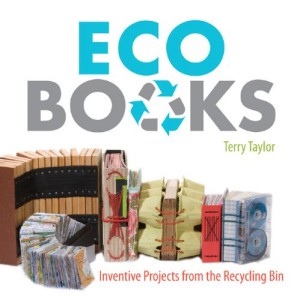
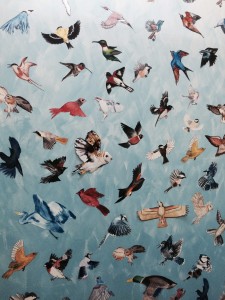
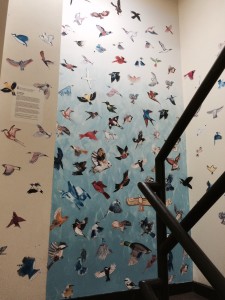
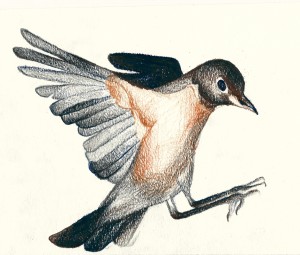
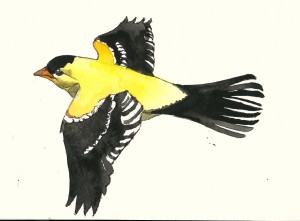
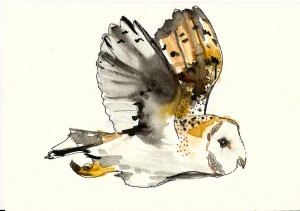
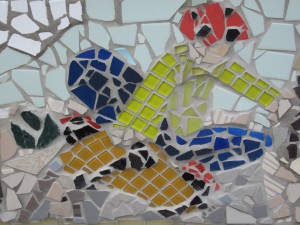
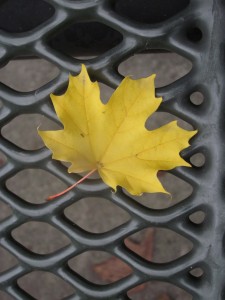
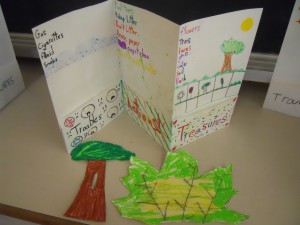

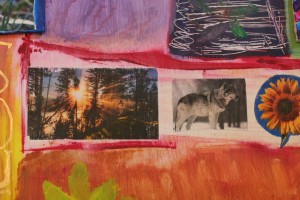 ô ô
ô ô 
